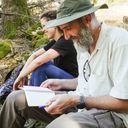Feb 8, 2022
The life cycle of a tree
How does a seed grow into a tree? Let’s look at the different stages in the life cycle to see how a tree feeds, reproduces and dies.

The tree is a complex living organism that goes through a number of stages in its life cycle as it grows, reproduces and eventually dies.
How does a seed grow into a tree? Most of us learn about trees in school, but it’s easy to forget the complex journey each tree takes. Let’s look at the different stages in the life cycle to see how a tree feeds, reproduces and dies.
Seed: where life begins
Every tree starts life as a seed. And every seed comes packed with all the nutrients it needs to survive and grow into a tree.
Seeds come in all shapes and sizes and get dispersed in different ways. They can be carried by the wind or animals, though cross-pollination by insects is much more common. This is just one reason it’s so important to protect and nurture biodiversity in our forests.
Once a seed finds and settles in an environment that has suitable conditions, it can move on to the next phase of its growth.

Germination: shoot to seedling
The next stage in the life cycle is the process of germination, where the plant begins to grow inside the seed.
The first root bursts through the seed and secures itself to the ground. It acts as an anchor and allows the seed to start absorbing water. Before long, a shoot will push its way up through the soil. The stem will emerge and you may see leaves poking through or rotting just below the surface.
Either way, when the shoot appears our seed has become a seedling. The tree’s life cycle is well and truly underway, but this is also when the plant is most at risk from disease and hungry animals, such as deers.
Here at EcoTree, as experts in sustainable forestry, we use a natural animal repellent called Trico. We apply Trico to ward away any animals who might want to munch on our young trees.
Sapling: reaching new heights
A seedling becomes a sapling when it reaches a height of roughly one metre.
We think of the sapling stage as the tree’s teenage years. It may grow quickly, but there is some way to go before it reaches full maturity. Its trunk is still flexible and its bark is smooth to touch.
Perhaps most importantly, a sapling cannot grow fruit and flowers, which means it is unable to produce seeds.

Mature tree: ready to reproduce
When a tree reaches maturity and can be considered fully grown, it is able to produce its very own fruit, flowers or nuts. That means it can reproduce and its seeds disperse for the life cycle to begin all over again.
A mature tree typically has a wide trunk and lots of branches that sprout leaves of many shapes and colours. In terms of a tree’s lifespan, this is the period when it is most productive. It has outgrown those teenage years and is a vital part of its wider environment.
Different tree species stay in this mature stage of the life cycle for longer than others. For example, an oak tree may produce acorns after 40 years and continue to do so for around 300 years. And yet the timescales for other species can be much shorter.
Want to know how old a tree might be? Every year it grows another ring of wood beneath its bark, which means you can add them up to get an idea of its age.
Decaying tree: essential to life
You might think that once a trees start to decay and reach the late stages of its life cycle, it becomes less useful. But that is not the case.
Every decaying tree or ‘snag’ is an essential part of any rich, biodiverse woodland or forest environment. A tree that once produced life now helps sustain it. It becomes home to insects and fungi and provides vital shelter to small creatures who can squeeze into its nooks and crannies.
Of course, all this action attracts larger animals, birds and other predators who visit the decaying tree to find food. As a tree slowly decays and dies, it contributes hugely to the biodiversity of the world around it.
Harvest: an alternative ending
Our team of foresters here at EcoTree are experts in sustainable forest management. Their years of experience means they know how to create forest conditions where trees can grow and thrive.
That means our forests include saplings, mature trees and decaying trees that help create a biodiverse environment. But our sustainable approach also allows us to do something else with our trees – we harvest them.
When we harvest a tree, it is turned into high-quality, sustainable timber used for furniture and building materials. What do we do with the proceeds? We invest it back into the forest by planting more trees that will go on that same life cycle.

Become a tree owner
Not only do we manage sustainable forests, our unique model means anyone can own a tree – including you! Read more about how it all works or choose your favourite species from the EcoTree treeshop.
